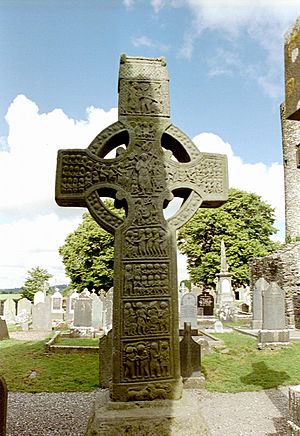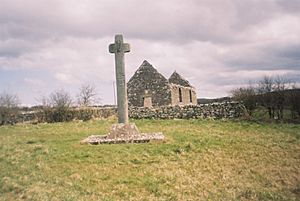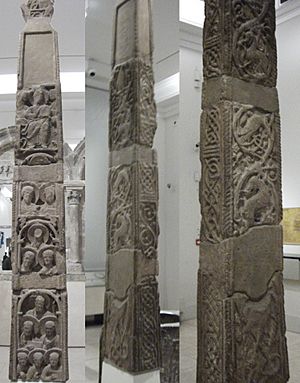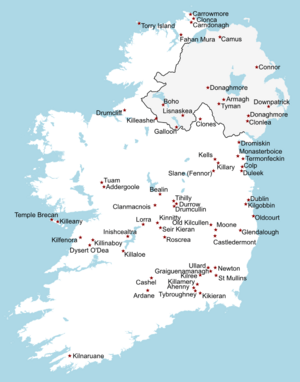High cross facts for kids
A high cross or standing cross is a tall, free-standing Christian cross made of stone. These crosses are often beautifully decorated. In Ireland and Britain, during the Early Middle Ages, people started a special tradition of putting up large, carved stone crosses outdoors.
These stone crosses likely grew from older traditions. People might have used wooden crosses, perhaps with metal decorations. They also might have been inspired by older pagan Celtic memorial stones. The Pictish stones in Scotland could have also influenced their design. The first high crosses that still exist seem to come from the Anglo-Saxon kingdom of Northumbria. Irish missionaries helped bring Christianity there. It's still not clear if high crosses first appeared in Ireland or Britain.
The carvings on these crosses mix religious figures with decorative patterns. These patterns include knotwork, interlace, and sometimes vine-scrolls in Britain. These styles are also seen in other Insular art, like illuminated manuscripts (decorated books) and metalwork. High crosses were probably painted with bright colors. Over time, the paint has worn off, and the stone has weathered. This makes the carvings, especially those with many small figures, hard to see clearly today.
The earliest crosses were usually about two meters (eight feet) tall. But later in Ireland, some crosses grew much taller, up to three times higher. They kept their thick, strong shape, which gave a lot of space for carving. The tallest Irish cross is the "Tall Cross" at Monasterboice, County Louth. It stands seven meters (twenty-two feet) high. Anglo-Saxon crosses were usually thinner. Their decoration was mostly patterns, not figures, except for some early ones from Northumbria.
High crosses often have a stone ring around where the cross arms meet. This forms what we call a Celtic cross. This ring seems to be an idea from Celtic Christianity, perhaps starting at Iona. The name "high cross" is mostly used in Ireland and Scotland. However, the tradition across Britain and Ireland is generally the same, even with some differences in style from region to region.
Some crosses were placed just outside churches and monasteries. Others were put in places that might have marked boundaries or crossroads. It's not clear if they were used as "preaching crosses" in early times. Many crosses have been moved from their original spots. They don't seem to have been used as grave markers in the early medieval period. In the 1800s, during the Celtic Revival, Celtic crosses became very popular for gravestones and memorials. You can now find them all over the world. Unlike the old Irish crosses, these modern ones usually don't have figures carved on them.
Contents
High Crosses in Ireland and Britain
High crosses are the most important large stone artworks that still exist from Insular art. Most of the crosses in Britain are found in areas that kept Celtic Christianity for a long time. We don't have any examples of the older wooden crosses or those with metal parts. But the designs on early stone crosses definitely borrowed from metalwork and illuminated manuscripts.
Saint Adomnán, who was the Abbot of Iona and died in 704 AD, wrote about similar free-standing wooden crosses with rings. These were later replaced by stone versions. Perhaps the oldest stone crosses that still stand are at Carndonagh, Donegal. It seems missionaries from Iona, who were escaping Viking raiders, put them up. This suggests Iona played a key role in creating ringed crosses. The round bumps seen on early crosses probably came from Pictish stones.
High crosses might have existed in Northumbria (which included parts of southeast Scotland) and Ireland from the 7th century. However, the dates for Irish crosses are now thought to be a bit later. Most early crosses that are in good condition, like those at Ruthwell and Bewcastle, or the Ossory group in Ireland, or the Kildalton Cross on Islay, seem to be from around 800 AD. This is true even though Northumbrian and Celtic types are different. Later, the high cross tradition spread to other parts of the British Isles. This included Celtic areas like Wales, Devon, Brittany, and Cornwall. Some examples can even be found in mainland Europe, especially where Insular missionaries brought the style.
Irish High Crosses
Most Irish high crosses have the special ringed shape of the Celtic cross. They are generally bigger and heavier than crosses elsewhere. They also have more carvings of figures. More Irish crosses have survived too. Many crosses in Britain were destroyed or damaged after the Reformation. Often, only parts of the main shaft remain. The ring on the cross first helped make the top and arms stronger. But it quickly became a decorative feature as well.
High crosses were symbols of importance. They showed the status of a monastery or the person who paid for them. They might also have been used as preaching crosses. Some crosses have inscriptions that name the person who ordered them, like Muiredach's High Cross. The earliest Irish crosses from the 8th or 9th century only had patterns, like interlace and round bumps. But from the 9th and 10th centuries, figures started to appear. Sometimes it was just a figure of Christ crucified in the middle. But on the largest 10th-century crosses, many figures covered most of the surface. Some later Irish crosses have fewer figures (often Christ with a local bishop or abbot). These figures are almost life-size and carved very deeply into the stone. The Irish tradition mostly ended after the 12th century. It was revived in the 1800s during the Celtic Revival. The Celtic cross shape became popular again for gravestones and memorials. These usually have only patterns and inscriptions. Today, you can find them all over the world, even in places with no special connection to the Insular Celts or Britain.
Anglo-Saxon High Crosses
Anglo-Saxon crosses were usually thinner. They were often almost square in shape. However, if they were close to Celtic Christian areas, like the Ruthwell Cross and Bewcastle Cross, they tended to be larger. This might have been to match local expectations. The two 9th-century Mercian Sandbach Crosses are the largest from that time anywhere. The tops of Anglo-Saxon crosses are usually smaller and often not Celtic crosses. However, most cross-tops have not survived at all. The carved figures on these large crosses are much bigger and carved more deeply than Irish crosses from similar times. Only some very late Irish crosses show equally large figures. Anglo-Saxon decoration often mixes panels of vine-leaf scrolls with interlace patterns. From a distance, they look similar to Celtic examples. Smaller crosses might have only had these patterns and inscriptions. Inscriptions are much more common on Anglo-Saxon crosses than on Irish ones.
After the Viking invasions, the Norse people who settled in the Danelaw (an area of England) adopted the high cross style. Some crosses combine Christian images with Norse myths. The Church seemed to accept this, perhaps as metaphors, while people were converting to Christianity. The Gosforth Cross, which is almost complete, is an example of this in England. By the 10th century, these Anglo-Norse crosses made up most of the crosses made in England. The high cross tradition seems to have stopped further south. However, the simple Dartmoor crosses, which helped people navigate Dartmoor, continued to be made for centuries. They were made from tough granite, so their decoration is usually light and hard to date. Market crosses, many of which date back to the Early Medieval period, have continued to be built and replaced up to modern times.
Pictish Crosses
In Pictish Scotland, a different type of cross developed called a cross-slab. This is a flat stone with a cross carved or scratched onto a mostly rectangular stone. It's a mix of a Pictish stone and a high cross. The cross is usually only on one side of the stone. The rest of the stone might be covered with interlace or other patterns. These cross-slabs are usually considered different from true high crosses.
The idea of putting up high crosses appeared when Norse settlers came to the British Isles and met Christian culture. A broken cross was found in Granhammar, Sweden. It shows that English missionaries were active in central Sweden. This Swedish cross was very similar to a cross in Leek, Staffordshire, England. It might have been made by an English immigrant.
In Norway, the British tradition was more widely accepted. About 60 stone crosses are known from Norway. Only four of them can be accurately dated to the Viking Age because they have runic inscriptions. Many of these crosses were probably put up in pagan burial grounds when families became Christian. Later, they were moved to cemeteries. The high cross tradition also likely helped make runestones (often with carved crosses) more popular in Sweden.
Famous High Crosses
Some of the most famous high crosses include:
- Muiredach's Cross and West Cross at Monasterboice, County Louth.
- The Clonmacnoise crosses: The Cross of the Scriptures (the original 9th-century cross is in a museum, but a copy stands where it used to be), and the North and South Crosses.
- The Nether (or Lower) Cross, a 9th-century granite cross with fancy carvings. It's in the graveyard of St. Canice's Church in Finglas village, Dublin. This cross was hidden in 1649 to protect it from Cromwell's forces. It was found 160 years later and moved to its current spot.
- The Anglo-Saxon Ruthwell Cross from Scotland, 8th century, known for its relatively large figures.
- The Anglo-Saxon Bewcastle Cross from Northumbria.
- The Anglo-Saxon Irton Cross, Cumbria, which looks similar to the Bewcastle style.
- The Pictish/Early Medieval Dupplin Cross in Strathearn, Scotland.
- The Pictish/Early Medieval Camus Cross in Angus, Scotland.
- Classic examples of 9th-century Pictish cross-slabs: Aberlemno 2 and 3 at Aberlemno, Angus.
- The 8th-century Kildalton Cross from the Hebrides.
- Iona Abbey has two crosses, with others on the island.
- Saint Tola's High Cross. This 12th-century cross at Dysert O'Dea near O'Dea Castle shows Christ and a bishop carved deeply on the east side. It has geometric patterns and animal designs on the other sides. The base shows the Temptation of Adam and Eve. This is a very well-preserved 12th-century example that does not use the circle of the Celtic cross.
- The Ahenny High Crosses. These two sandstone crosses date from the 8th to 9th centuries. They are among the earliest ringed high crosses. They are in Ahenny, County Tipperary, near the Kilkenny border, and the monastic site of Kilclispeen.
- Ardboe High Cross, a 10th-century cross near Cookstown. It is worn down but shows 22 panels with scenes from the Old and New Testaments.
- St. Kevin's Cross, Glendalough, a well-preserved 12th-century cross made of granite.
- South Cross, Kells, County Meath, the best-preserved of several 10th-century crosses in the town.
- Doorty Cross, Kilfenora, County Clare; 12th century, has a bishop and two other religious figures carved on it.
- Kilree High Cross, a 9th-century high cross said to be the burial place of Niall Caille. It is located 4 km southeast of Kells Priory, County Kilkenny.
- Kilkieran High Crosses, three crosses near Ahenny, County Tipperary: Plain Cross (no decoration), West Cross (lots of decoration), Long Shaft Cross (a long decorated shaft).
- The two Moone High Crosses, in County Kildare near Moone. The large cross is thought to have been carved between 900 and 1000 AD. It is highly decorated and 5.33 meters high.
Modern High Crosses
Since the 1800s, many large modern versions of high crosses have been put up for different reasons. Smaller Celtic crosses have also become popular for individual grave markers. These usually only have abstract patterns, like interlace.
In 1887, Rev. William Slater Calverley had a life-sized copy of the Gosforth cross made. He had it put up in the churchyard at Aspatria, Cumbria.
In the early 2000s, Irish sculptor Brendan McGloin was asked to make a full-size copy of the Clonmacnoise Cross of the Scriptures. This 13-foot, 5-tonne sandstone cross was finished in 2007. It was shipped from Donegal to Portland, Oregon, where it stands as a memorial to the Famine. In 2016, a high cross was put up outside Wakefield Cathedral in West Yorkshire, England. It was carved from stone from Holmfirth by Celia Kilner. This cross was based on the remains of a Saxon high cross from 930 AD.
Images for kids
-
Kildalton Cross (Islay, Scotland)
-
Saint Tola's Cross (Dysert O Dea, Ireland)
-
Kirkyard Stone, Class II Pictish cross-slab, Aberlemno, Scotland
-
Downpatrick Cross (Downpatrick, Northern Ireland)
-
Cadover Cross, one of the Dartmoor crosses (Dartmoor, England)
-
Ruthwell Cross (Ruthwell, Scotland)
-
Ullard high cross
-
A high cross at Monasterboice in Ireland
See also
 In Spanish: Alta cruz para niños
In Spanish: Alta cruz para niños





















